
By studying soft and biological materials with sophisticated tools like neutron beams, graduate students in biophysics are able to develop advanced analytical skills that can be transferred to a wide range of professional careers in all areas of Canada’s economy.
Source: Canadian Neutron Beam Centre (CNBC)
Contact: cnbc@cnl.ca
Image: Young Canadians are using biophysics research using neutron beams as launch pads for their careers
“Choose science” has been the message to young people and their parents from Canada’s Minister of Science, Kirsty Duncan. That’s because science not only generates valuable knowledge, it also develops confidence and skills in the young people who participate in the scientific process.
This is especially true of fundamental science, which both challenges and inspires. Some young people are stirred by the prospect of making important scientific discoveries and will stay in science throughout their careers. Many others will make a contribution to science during their undergraduate and graduate studies and then apply their new skills to professions in business, industry, or government. Regardless, their scientific backgrounds enable these young people to enhance Canadian innovation and competitiveness across the board.
Of Professor Rheinstädter’s other recent graduates, one has gone on to medical school; another enables Internet-of-Things-connected municipal water systems; and a third is manager of R&D at an environmental technology company.
Laura Toppozini
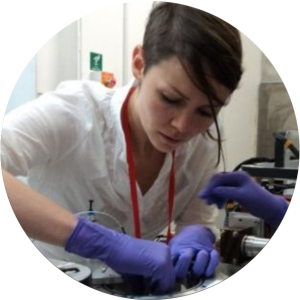
Dr. Laura Toppozini, shown here working in a lab at McMaster, is now a financial analyst.
One young person who is applying her scientific training to fields beyond the laboratory is Laura Toppozini. Laura studied physics at Lakehead University in her home town of Thunder Bay before going on to complete her PhD in physics at McMaster University. There, she did research on a variety of topics to generate fundamental knowledge. One such research initiative used neutron beams to study how drugs interact with lipid membranes on a molecular level.
Today, Laura is using her skills to analyze financial investment strategies at Neuberger Berman Breton Hill ULC, a Toronto-based investment firm that manages about $2 billion in client assets, including funds from public pension plans.
While completing her studies at McMaster, Laura was able to travel to the U.S., England, France, and Germany to perform research, visit leading scientific facilities, and attend conferences. She looks back on these opportunities as being formative in terms of developing networking skills and the ability to work effectively with a variety of people.
During her PhD studies, she also learned how to write code to take in data, as well as how to analyze that data to test a hypothesis—skills she first honed with data from neutron beam experiments for her research. Data analysis also requires developing creativity, to identify other possible explanations of the data.
Now Laura applies her creativity and analytical skills to identify the difficult-to-find patterns in investment market data. She is pleased with the contributions her work makes to Canadian society, because it increases people’s quality of life in retirement. People are trusting her firm with their money – people who are depending on them to develop robust strategies.
The neutron beam experiments that Laura performed as a PhD candidate were conducted under Professor Maikel Rheinstädter, whose membrane biophysics research lab has hosted several recent Masters and PhD graduates. Of these, one has gone on to medical school; another is analyzing and managing data from municipal water systems that are connected to the Internet of Things; and a third is the manager of research and development at a company whose technology could mitigate the environmental impact of oil sands tailings.
Rick Alsop
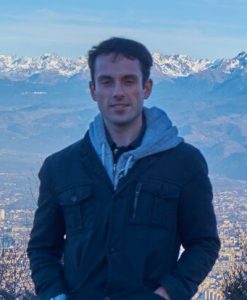
Dr. Rick Alsop is now a business consultant.
A fourth student who worked under Maikel Rheinstädter is Rick Alsop. Currently, Rick works in business consulting at PwC Canada, where he helps clients use data to mitigate, manage, and take advantage of risk in various segments of the economy. “For example, a retailer may come to us seeking advice on how to reduce risks of inventory losses due to theft or other causes, and we would analyze data from their operations and supply chain to identify the most effective solutions for reducing their risk,” Rick explains. “They may also want to learn how to be more sustainable, or how to manage the risks of emerging technologies such as artificial intelligence.”
Originally from Collingwood on the shores of Georgian Bay, Rick was initially attracted to pursuing graduate research with Rheinstädter because of Rheinstädter’s compelling use of neutron beams to study biological systems.
In fact, it was this unique interplay between serious physics and pure biology that challenged Rick to learn how to convey unique and complicated ideas to diverse audiences. “I had to communicate my findings to biologists, because I was studying biological problems, not neutrons,” he recalls. “The biologists weren’t familiar with our methods or what we were trying to do, so our group had to communicate effectively.”
Today, Rick views his capacity to communicate complicated ideas to clients as one of his most valuable skills. What’s more, like Laura, Rick feels that the ability to handle lots of data has proven valuable in his current work. “I learned how to spend days pouring through data to get an answer,” he says. “This dedication and curiosity are invaluable in business, as well as in science.”
Feryaal Ahmed

Feryaal Ahmed is now at Western University’s Ivey Business School.
Feryaal Ahmed intends to establish a career in the business side of the science enterprise. Born in Saskatchewan to Pakistani parents, Feryaal attended Brock University after her parents relocated to southern Ontario. She chose to pursue a degree in biophysics because she liked both biology and physics. Due in part to the one-on-one time spent with her professors at this smaller university, Feryaal became interested in the work of Professor Thad Harroun, who uses neutron beams to study molecular behaviours.
Feryaal volunteered to work in Harroun’s biophysics research lab during the summer after her first year. She returned in subsequent summers, winning NSERC undergraduate research awards to support her time in the lab.
It was through this summer work that Feryaal discovered the career path she wanted to pursue. “I went with Professor Harroun’s research team to a large neutron beam facility to help with an experiment, just when I was on the cusp of figuring out what I wanted to do,” she notes. “That visit opened my eyes.” Indeed, in addition to developing a suite of analytical skills, her participation in the research process taught her a lot about how science works, including the ‘business of science.’
“I saw that massive operations—and corresponding funding—were required to support the science at these facilities, and I said, ‘I want to know how this business is run’,” recalls Feryaal. “There was also the synergy of people from different countries working together at an international centre, using versatile research tools. I saw an international business challenge in forming relationships with other countries to make that work.”
That inspiration has led her to the Ivey Business School at Western University, where she will soon complete her MSc in Business Analytics. While she is confident that her training in operations research and business analytics can be applied to a wide range of businesses after she graduates, Feryaal hopes to find a position where she is responsible for the operations of a science facility.
Drew Marquardt
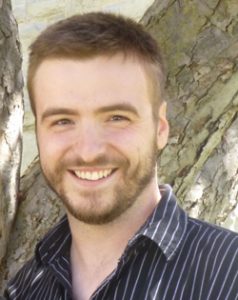
Dr. Drew Marquardt is now a professor at the University of Windsor.
Another graduate who conducted research under Thad Harroun’s supervision at Brock University is Drew Marquardt, whose early research success earned him a prestigious Vanier Canada Graduate Scholarship in 2012.
Speaking at the time, Drew said, “My award is 100 percent connected to the Canadian Neutron Beam Centre, not only because all my publications were enabled by access to the neutron beamlines, but also because neutron beams allow me to study potentially high-impact problems in biology.” Drew has since published several insightful papers (e.g., on Vitamin E and cholesterol) that arose out of his graduate research with neutron beams.
Drew’s success as a graduate student enabled him to travel abroad to work with other leading scientists in his field. In 2014, he began his first stint abroad as a postdoctoral fellow at the University of Graz in Austria. From there, he went to the U.S. for his second postdoctoral research position, which was in joint association with Oak Ridge National Laboratory and the University of Tennessee.
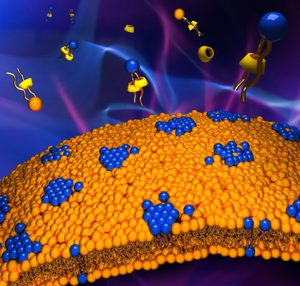
Drew’s research involves cell membranes and the biomolecules that interact with them, as illustrated in this cover image from Langmuir.
In July 2017, Drew returned to Canada to work as a professor of chemistry at the University of Windsor, where he is currently establishing a reputation as a leading scientist. In fact, Drew was recently awarded the 2017 Best Paper Award by the journal Membranes. His work has also been featured on the covers of scientific journals seven times in the past three years, including on the January 2018 issue of Biophysical Journal.
Now, it is Drew’s turn to help develop skills and confidence in young Canadians by engaging them in his own research program. “My students and I are exploring fundamental scientific questions which could lead to new platforms for developing and testing new drugs,” he explains. “We aim to find better ways of targeting drugs to specific medical conditions for treatment or diagnostic imaging.”
John Atkinson

John Atkinson is a PhD student at the University of Guelph.
As for current biophysics students, many see promise in future careers at companies that are commercializing applications of soft or biological materials.
John Atkinson, a PhD student at the University of Guelph, is conducting research under physics professor John Dutcher. Dutcher founded Mirexus Biotech after the serendipitous discovery in his lab of a material that his company describes as “natural, corn-based, phyto-glycogen nanoparticles, which have the unique advantage of being safe, biodegradable and non-toxic.” It was this material, which is being commercialized for applications in the personal care industry, that John Atkinson was particularly interested in studying and attracted him to study under Dutcher.
Since coming to Guelph, John has used a variety of experimental techniques in his studies. He has found that neutron beams are especially valuable for characterizing many biomaterials, including phyto-glycogen nanoparticles.
John is quick to acknowledge the role that neutron beam experiments have played in helping him develop key data analysis and modelling skills. He notes that proper analysis requires more than just feeding data into a computer. “You have to make sure the results of the analysis and modelling make sense. It is easy to fit the data and say, ‘Hey, it fits, therefore it’s correct.’ But it’s important to evaluate the result and determine whether it represents an explanation of the material that is physically realizable and consistent with observations made by others.”
Eric Schibli
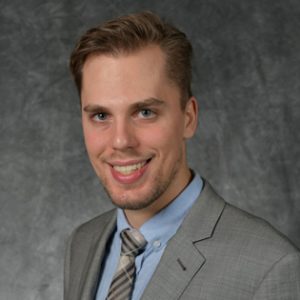
Eric Schibli is a graduate student at Simon Fraser University.
Eric Schibli hopes to pursue a career in the energy industry. Originally from Smithers, BC, Eric earned an undergraduate degree in physics from the University of Northern British Columbia before beginning graduate studies at Simon Fraser University. There, he became interested in working under physics professor Barbara Frisken, who is known for her research on alternate energy technologies.
Eric’s research focuses on understanding ion-conducting membranes, such as those used in fuel cells. So far, he has used multiple approaches (e.g., neutron beams, x‑rays, and computer simulations of the material on the atomic scale) to model these complex membranes. “This material is like a puzzle,” he says. “I enjoy the challenge of figuring out how it works.”
Eric also enjoys the challenge of conducting neutron beam experiments at large central facilities, which he feels fosters the ability to work under pressure. “You have to work under high time pressure to get the experiment done in your limited time allotted on the beamline,” he explains. “You have a short period of time to interact with the local experts at the facility before plunging into the experiment, during which you have jet lag and you have to work around the clock on little sleep.”
Eric’s ability to work under pressure bodes well for his future career aspirations. “I would like to work on materials in the private sector, most likely in the energy industry,” he says. “Materials like what I’ve been studying are used in fuel cells and batteries, as well as water treatment and other industrial applications.”
Neutron beams and the future of biomaterials research in Canada
One thing that all these young graduates and students have in common is their appreciation of the neutron beam facilities that enabled their biophysics research. In the same vein, the pending loss of the Canadian Neutron Beam Centre in Chalk River and the expiry of Canada’s only agreement with a foreign neutron source this year are factors that could very well impact the ability of current and future students to benefit from conducting such research.
For instance, although John would like to stay in Canada after completing his PhD, he notes that “We wouldn’t be able to do [our] research without the instrument scientists [who specialize in running neutron beam experiments].” For that reason, a domestic hub of expertise in neutron beams is important to enable researchers like John, in universities and industries across the country, to use these irreplaceable tools.
Similarly, Eric hopes to see Canadian participation in large central scientific user facilities, which no Canadian university could ever afford on its own. In his view, such facilities are vital—and not just for the knowledge generated by the experiments they facilitate. “They also enable research connections, as many scientists access them simultaneously,” he explains. “The U.S.’s network of these large user facilities has been one of their secrets to success; while it’s unfortunate that Canada is losing its own neutron beam facility, it would be a double loss if we now fail to actively participate in world-leading facilities elsewhere.”
As a new professor training the next generation of scientists, Drew also sees access to these user facilities as being critical to the future of post-graduate research programs in Canada—including his own. “Access to neutron beams will be very important to my whole research team if we are to continue the research program on lipid membranes,” he says.
